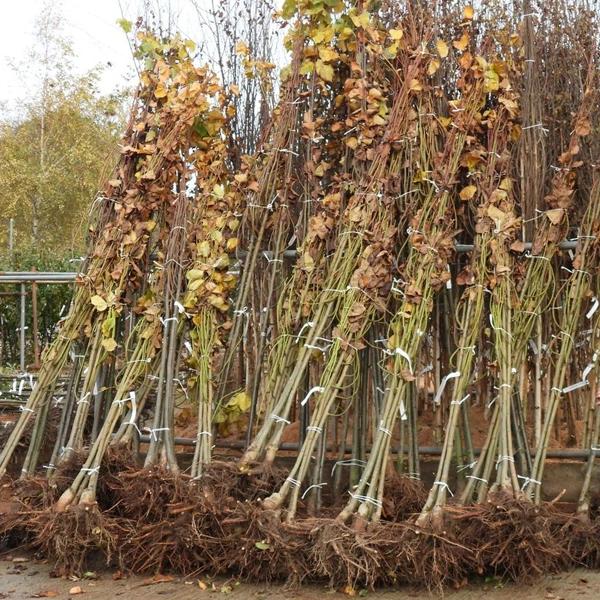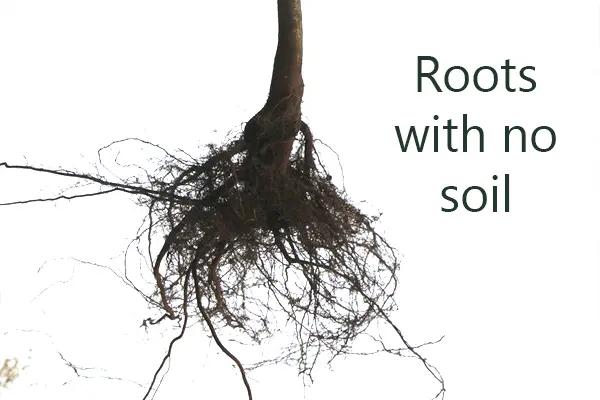Table of Contents
Bareroot means no soil around the roots when delivered
The majority of hedging plants and trees in the UK are planted bareroot, but for many new gardeners, the idea of buying a plant with no soil around its roots feels wrong: how can they survive transit without a pot?

The secret is that they are dormant, sleeping in Winter. They don’t mind being lifted without soil because their roots are not active, the tree is not using up water.
All bareroot means is that there is no soil around the roots of a plant when it is delivered and transplanted.
Bareroot plants are very common, almost all flower bulbs are planted when dormant with neither leaf nor root.
But not everyone knows that most large scale plantings are bareroot, about 90% of all hedging and trees, and over half of all roses.
All plants slow down in the winter as temperatures drop and light levels fall.
Deciduous trees and shrubs lose their leaves in winter and go to sleep completely.
Evergreen plants such as yew do not become completely dormant, but they are sleepy enough!
While in “shut down mode” they only need sufficient dampness at the root to prevent desiccation and cell damage.
Bareroot trees and plants have a number of significant advantages over their pot grown versions:
- Bareroot plants are grown in open ground which means they tend to be bigger and stronger than potgrown stock
- For the same reason they are less likely to suffer from the family of diseases generally known as “root root”
- Because there is no need for pots, compost and pot specific watering systems they are much cheaper to produce and buy
- There are no heavy rootballs or pots with compost to pack and transport. This makes carriage either vastly cheaper or quite simply, possible.
- For the eco-conscious, bareroot plants are generally carbon positive (good for the climate) which potted and rootballed stock are not.
Without wishing to labour the point, 500 bareroot hawthorn hedging plants weigh less than 25kgs. The same plants in 2 litre pots would weigh a tonne. Literally. Or, a bare rooted 6/8 standard english oak can be easily lifted with one hand. The same tree in a suitably sized pot is a two-man lift.
To paint the picture fairly, there are some (relatively minor) disadvantages as well.
- Bareroot plants suffer some root loss when they are lifted. In the long run this is good as root pruning creates a denser rootball, but in the short term it means they take a little longer to start growing after planting than potted plants. Root-loss is less in smaller plants than larger trees.
- Because of this root loss, barerooted plants are more prone to die of thirst if they are not watered when it is dry in the spring and early summer after planting.
- Because near-dormancy is necessary for bareroot planting, the season is restricted to the months of November – April (May in a late spring).
What Do Bareroot Plants Look Like?
When you order bareroot beech hedging from us, here’s what you’ll receive in the post and how to care for it until you’re ready for planting.
VIDEO TRANSCRIPT
Today, we’re going to talk a little bit about bareroot hedging, specifically beech hedging that you’ll receive if you order any hedging from Ashridge Nurseries. So, we’ve got three of the most popular sizes we sell, the first one is 80/100cm, so this is one of the smallest ones we do, just about up to the waist. 100/125cm, which is just past your waist if you’re the same size as me.
One of the biggest ones we do is 150 to 175cm. So that’s probably about five-year-old. This one, probably about three or four. This one, probably two or three. So you’ve got a lot of time invested in there already.
When they turn up, they’ll be completely wrapped. So, they’ll be in a plastic bag, and they’re wrapped to protect all the stems. When you unwrap them, if you’re not going to plant them straight away, get them unwrapped, you can either leave them in the packaging, but just take the top off so that they’ve got a bit of air to breathe, or if you take it all completely off, just get an old plastic bag, slip them in, put them in, sprinkle a bit of water in there and tie them up. As long as the tops are out of there and the roots are in the dark, and they’re nice and moist, they’ll probably last about a month.
When you get them, just check for any damage. None of the stems have been snapped and the roots are all right. With beech hedging, don’t worry too much if there’s leaves left on there, they’ll start to drop off. A beech hedge has the ability to keep the leaves on and it’s one of the most popular features of beech anyway. Once it’s pruned and trimmed, it tends to keep the leaves over winter. If you’re not quite ready to plant just at the moment, you can either put them in a plastic bag, which we showed you, or you can dig a trench in the garden, just lay them down and as long as the roots are covered with soil, compost or whatever you want. Give them a water, and they’ll stay quite happily over winter until you’re ready to plant.
Is bare root better than potted?
Bare-root plants are only delivered and planted in the winter season, from November to April. Pot grown plants can be delivered and planted all year round.
Most plants are sold either bareroot only (e.g. all large trees and most hedge plants) or pot grown only (e.g. lavender and climbing plants), so there is no decision to be made, but some, like rose bushes or beech hedging, are sold bareroot in winter and pot grown the rest of the year.
Advantages of Bare-root plants
- You pay less for the same size plants.
- You can carry and plant them more easily.
- You only plant them in winter, so they need less maintenance after planting. The ground is naturally wet for their first few months.
- You get the biggest selection: Many trees are not sold pot-grown.
- They are “asleep” in winter – this is the best time to transplant any tree.
- They use fewer fertilisers & fungicides, less water and less packaging and fuel in their production & delivery.

Advantages of Pot Grown plants
- Can be delivered & planted all year round.
- Plants with tender roots & larger specimens must be delivered in pots or rootballs.
- Can be kept for longer if there is a delay in planting.
Our Seasonal Advice:
- Spring from the end of the bareroot planting season is a great planting time: order pot grown plants and water them well
- Mid-summer’s heat at its peak is stressful for a new plant. If the site is out in full sun and wind, it’s often preferable to delay planting until it cools to avoid the risk of leaves wilting
- By early Autumn, planting conditions are good, but the bareroot season is maybe three months away, so it’s up to you how that works for your schedule.
- Late Autumn to early Spring, roughly November to March, is the bareroot planting season. Bareroot plants are better value and more convenient to work with than their pot grown equivalents.
- In any cases, it’s good to order early. We don’t take payment until before delivery.
Buying Bareroot: Winter Delivery Seasons Explained
We do sell some big trees in pots during summer, but we mostly deliver them barerooted in the winter season, November – March.
You can place your order for large trees outside of the season, and we will not charge your card until they are ready for delivery.
Barerooted Large Trees are:
- Easy to deliver, carry around and plant
- Best value for money
- Guaranteed for their first year
- Even more likely to establish successfully than pot grown trees, especially if they don’t receive adequate water
Reserve bareroot plants in summer
- Book the plants you want before they sell out,
- Choose your winter delivery date before a queue builds up
Rootballed Trees: Certain trees and large sizes of hedging like Yew need to be transported with a protective ball of earth around their roots.
These rootballed plants are also delivered in winter, sometimes with a slightly longer delivery season from October-April, but still depending on the weather.
